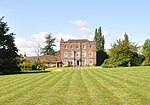Billington, Bedfordshire

Billington is a civil parish in Bedfordshire about 3 miles (4.8 km) south of Leighton Buzzard and not far from the Buckinghamshire border. There are two settlements: Little Billington (a hamlet in the west of the parish) and one that is now called Great Billington (straddling the A4146). At the 2021 census, the parish had a population of 359.The name of the parish is recorded in 1196 as Billendon, and may come from Anglo-Saxon language Billan dūn = "hill of a man named Billa". Another theorized original meaning is "hill with a sharp ridge". The spelling Billyngdon appears in a legal record, dated 1440, where Hugh and Thomas Billyngdon of Billyngdon, Beds, gentlemen, are mentioned.The village is known for its high density of Travellers, who outnumber the settled community. This community live in privately owned, but permitted, sites in the village, three in Little Billington and one between Billington and the nearby village of Stanbridge. The centre of Great Billington is Billington Hill, on top of which is the small parish church. The church was originally a small mediaeval chapel; however, in the late 1860s it was enlarged to a church, and a rectory built next to it to house the first incumbent. This was when Billington was first recorded as a parish in its own right. The bell turret of the church (it has no tower) came to the church secondhand, from the church at nearby Linslade, which was being enlarged at the time. The interior of the church is very simple; a small stained glass window in the west wall commemorates Edward Bradshaw, the first rector. The village once had a common, where the peasants cultivated their own strips of land; the name 'common' still survives as a field name. It was enclosed at the time of the enclosures, and is today part of a local farm. It is traversed by two public footpaths. The village contains some half-timbered thatched cottages, in the area around the summit of the hill, and also some old farmhouses and cottages. One of the thatched cottages on top of the hill has the dubious honour of having featured on countless chocolate boxes and biscuit tins. One of the more attractive houses in the village is Walkers Farm, a brick and timber house dating from the 16th century. Its once-thatched roof is now tiled. During the late 1870s and early 1880 large areas of the village were bought by Arthur Macnamara who built at this time the manor house, and transformed the village into a typical Victorian estate village. The village school, halfway up the hill, was built at this time. It closed in the 1950s. In the early 20th century a point-to-point course was built on the estate, people came from all over England to attend the race meeting held there. Edward VIII when Prince of Wales was a frequent competitor at the races. The races discontinued after World War II.
Excerpt from the Wikipedia article Billington, Bedfordshire (License: CC BY-SA 3.0, Authors, Images).Billington, Bedfordshire
Leighton Road,
Geographical coordinates (GPS) Address Nearby Places Show on map
Geographical coordinates (GPS)
| Latitude | Longitude |
|---|---|
| N 51.896 ° | E -0.635 ° |
Address
Leighton Road
Leighton Road
LU7 9HF , Great Billington
England, United Kingdom
Open on Google Maps






